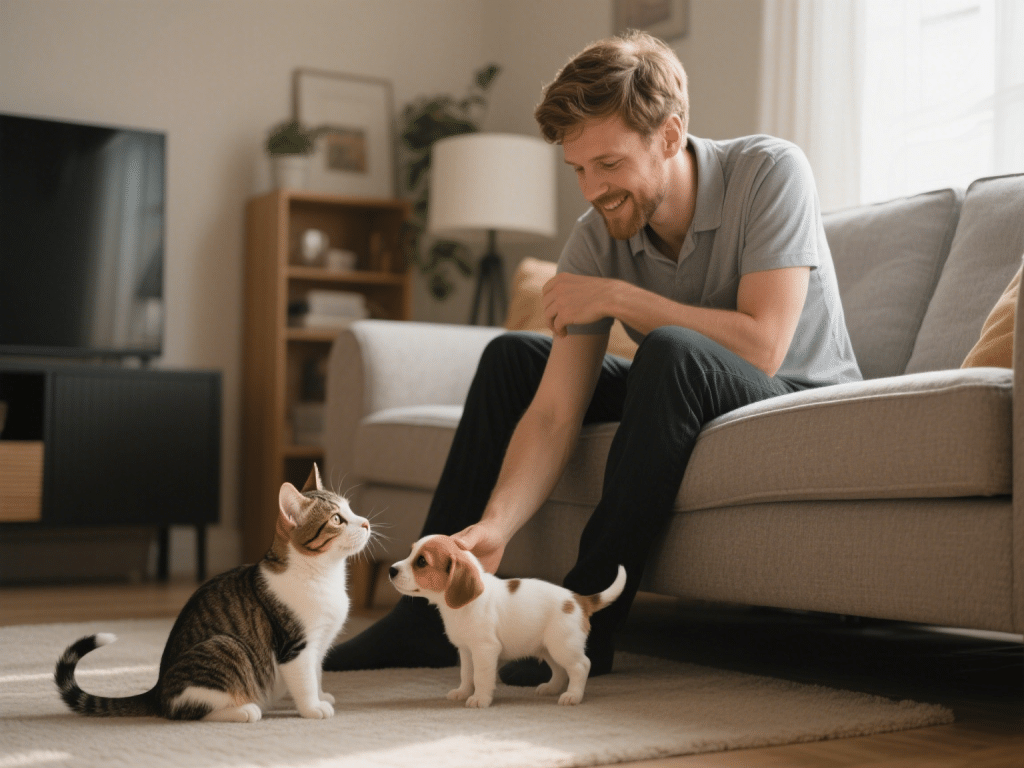
Introduction
Bringing a new puppy into a household with an established cat can be challenging. Cats are territorial, and sudden canine energy may overwhelm them. With careful planning, controlled introductions, and positive reinforcement, you can help both pets build trust and respect. This guide outlines a gradual, stress-minimizing approach to nurturing peaceful coexistence between a new puppy and your resident cat.
1. Pre-Arrival Planning
1.1 Prepare Separate Safe Zones
Cat’s Sanctuary:
Provide an elevated retreat (cat tree or high shelf) inaccessible to the puppy.
Ensure the cat has exclusive access to food, water, litter box, and cozy resting spots.
Place a pheromone diffuser (Feliway Classic) near the cat’s primary area to reduce stress.
Puppy’s Den:
Set up a crate or gated area in a separate room with comfortable bedding, toys, and water.
Include chew-resistant puzzle toys to keep the puppy mentally stimulated in the absence of the cat.
1.2 Scent Exchange and Familiarization
2. Controlled Face-to-Face Introductions
2.1 Choosing the Right Timing
2.2 First Meeting Strategies
Leashed Puppy, Free Cat:
Place the puppy on a loose leash, allowing the cat to decide on proximity.
Maintain a relaxed, neutral posture. Stand or sit sideways to avoid looming over the cat.
Keep the meeting under 3 minutes initially; extend by 1–2 minutes each day if calm.
Reading Body Language:
Cat’s Signals of Comfort: Tail held low or neutral, ears forward or slightly to the side, slow blinking.
Cat’s Signals of Fear/Discomfort: Hunched posture, flattened ears, wide pupils, swatting or hissing.
Puppy’s Signals: Play bows and wagging tails indicate excitement—redirect if too intense by encouraging a “sit” command with treats.
3. Building Positive Associations
3.1 Parallel Positive Reinforcement
Simultaneous Rewarding:
Offer palatable treats to both pets during proximity sessions. This teaches them that being near each other leads to positive outcomes.
Gradually decrease treat frequency as calm cohabitation becomes routine.
3.2 Shared—but Supervised—Sessions
3.3 Creating a Routine
4. Long-Term Coexistence Strategies
4.1 Maintaining Respectful Boundaries
4.2 Addressing Behavioral Issues Promptly
4.3 Socialization and Enrichment
5. When to Seek Professional Help
Persistent Aggression or Fear:
If the cat shows prolonged stress (refusal to eat, hiding for >48 hours) or the puppy’s prey drive leads to lunging or barking, consult a certified professional (veterinary behaviorist or qualified trainer).
Medical or Behavioral Assessment:
Tailored Behavior Modification Plan:
Conclusion
Introducing a new puppy to your resident cat requires patience, consistency, and structured steps. By preparing separate safe zones, facilitating gradual scent and visual introductions, using positive reinforcement, and respecting each pet’s boundaries, you can cultivate a peaceful coexistence. Ongoing training, enrichment, and prompt intervention for problem behaviors ensure both animals thrive in harmony. With commitment and mindful management, your household can achieve a loving, multi-pet dynamic.